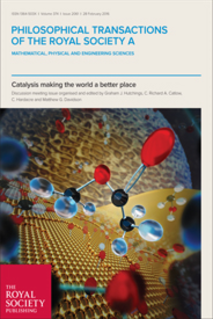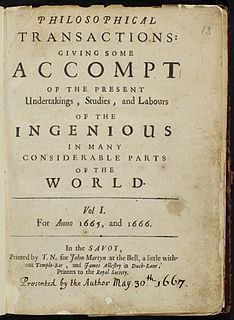
Savant syndrome is a condition in which someone with significant mental disabilities demonstrates certain abilities far in excess of average. The skills at which savants excel are generally related to memory. This may include rapid calculation, artistic ability, map making, or musical ability. Usually just one special skill is present.

The President, Council and Fellows of the Royal Society of London for Improving Natural Knowledge, commonly known as the Royal Society, is a learned society. Founded on 28 November 1660, it was granted a royal charter by King Charles II as "The Royal Society". It is the oldest national scientific institution in the world. The society is the United Kingdom's and Commonwealth of Nations' Academy of Sciences and fulfils a number of roles: promoting science and its benefits, recognising excellence in science, supporting outstanding science, providing scientific advice for policy, fostering international and global co-operation, education and public engagement.

The Royal Asiatic Society of Great Britain and Ireland, commonly known as the Royal Asiatic Society (RAS), was established, according to its Royal Charter of 11 August 1824, to further "the investigation of subjects connected with and for the encouragement of science, literature and the arts in relation to Asia." From its incorporation the Society has been a forum, through lectures, its journal, and other publications, for scholarship relating to Asian culture and society of the highest level. It is the United Kingdom's senior learned society in the field of Asian studies. Fellows of the Society are elected regularly. Fellows include highly accomplished and notable scholars of Asian Studies.
The Journal of the Chemical Society was a scientific journal established by the Chemical Society in 1849 as the Quarterly Journal of the Chemical Society. The journal underwent several renamings, splits, and mergers throughout its history. In 1980, the Chemical Society merged with several other organizations into the Royal Society of Chemistry. The journal's continuity is found in Chemical Communications, Dalton Transactions, Faraday Transactions, and Perkin Transactions, all of which are published by the Royal Society of Chemistry.

The Journal of the Chemical Society, Faraday Transactions was a peer-reviewed scientific journal published from 1905 until 1998. The journal was originally published by the Faraday Society under the name Transactions of the Faraday Society and was renamed in 1972.

Dalton Transactions is a peer-reviewed scientific journal publishing original (primary) research and review articles on all aspects of the chemistry of inorganic, bioinorganic, and organometallic compounds. It is published weekly by the Royal Society of Chemistry. The journal was named after the English chemist, John Dalton, best known for his work on modern atomic theory. Authors can elect to have accepted articles published as open access. The editor is Andrew Shore. Dalton Transactions was named a "rising star" by In-cites from Thomson Scientific in 2006.
Perkin Transactions is a scientific journal devoted to organic chemistry published from 1997 to 2002 by the Royal Society of Chemistry. It was split into Perkin Transactions I and Perkin Transactions II. The predecessor journals published by the Chemical Society before the merger of that Society with other Societies to form the Royal Society of Chemistry were the Journal of the Chemical Society, Perkin Transactions 1 and Journal of the Chemical Society, Perkin Transactions 2 (1972-1996). They were replaced by Organic and Biomolecular Chemistry.
Arthur William Baden Powell was a New Zealand malacologist, naturalist and palaeontologist, a major influence in the study and classification of New Zealand molluscs through much of the 20th century. He was known to his friends and family by his third name, "Baden".
The Journal of the Royal Society of Medicine is an open peer-reviewed medical journal. It is the flagship journal of the Royal Society of Medicine with full editorial independence. Its continuous publication history dates back to 1809. Since July 2005 the editor-in-chief is Kamran Abbasi, who succeeded Robin Fox who was editor for almost 10 years.

Philosophical Transactions of the Royal Society B: Biological Sciences is a biweekly peer-reviewed scientific journal published by the Royal Society. The editor-in-chief is John Pickett.

Philosophical Transactions of the Royal Society A: Mathematical, Physical and Engineering Sciences is a fortnightly peer-reviewed scientific journal published by the Royal Society. It publishes original research and review content in a wide range of physical scientific disciplines. Articles can be accessed online a few months prior to the printed journal. All articles become freely accessible two years after their publication date. The current editor-in-chief is John Dainton.
The Catalogue of Nebulae and Clusters of Stars (CN) is an astronomical catalogue of nebulae first published in 1786 by William Herschel, with the assistance of his sister Caroline Herschel. It was later expanded into the General Catalogue of Nebulae and Clusters of Stars (GC) by his son, John Herschel. The CN and GC are the precursors to John Louis Emil Dreyer's New General Catalogue (NGC) used by current astronomers.

The Lyginopteridales were the archetypal pteridosperms: They were the first plant fossils to be described as pteridosperms and, thus, the group on which the concept of pteridosperms was first developed; they are the stratigraphically oldest-known pteridosperms, occurring first in late Devonian strata; and they have the most primitive features, most notably in the structure of their ovules. They probably evolved from a group of Late Devonian progymnosperms known as the Aneurophytales, which had large, compound frond-like leaves. The Lyginopteridales became the most abundant group of pteridosperms during Mississippian times, and included both trees and smaller plants. During early and most of middle Pennsylvanian times the Medullosales took over as the more important of the larger pteridosperms but the Lyginopteridales continued to flourish as climbing (lianesent) and scrambling plants. However, later in Middle Pennsylvanian times the Lyginopteridales went into serious decline, probably being out-competed by the Callistophytales that occupied similar ecological niches but had more sophisticated reproductive strategies. A few species continued into Late Pennsylvanian times, and in China persisted into early Permian (Asselian) times, but then became extinct. Most evidence of the Lyginopteridales suggests that they grew in tropical latitudes of the time, in North America, Europe and China.

A total solar eclipse occurred on Tuesday, September 8, 1885. A solar eclipse occurs when the Moon passes between Earth and the Sun, thereby totally or partly obscuring the image of the Sun for a viewer on Earth. A total solar eclipse occurs when the Moon's apparent diameter is larger than the Sun's, blocking all direct sunlight, turning day into darkness. Totality occurs in a narrow path across Earth's surface, with the partial solar eclipse visible over a surrounding region thousands of kilometres wide.
The path of totality crossed New Zealand.
The Transactions and Proceedings of the Royal Society of New Zealand was a scientific journal and magazine published by the Royal Society of New Zealand. Before 1933 the society was called the New Zealand Institute, and the journal's name was Transactions and Proceedings of the New Zealand Institute. It was active between 1868 and 1961 and was the most important scientific journal in New Zealand.
The Journal of the Royal Astronomical Society of Canada is a bimonthly peer-reviewed scientific journal published by the Royal Astronomical Society of Canada since 1907. The title in French is Journal de la Société royale d'astronomie du Canada.
The Yankuntjatjarra, otherwise written Jangkundjara, are an indigenous Australian people of the state of South Australia.
The Pongaponga were an indigenous Australian people of the Northern Territory. They may have been a band of the Ngolokwangga.









